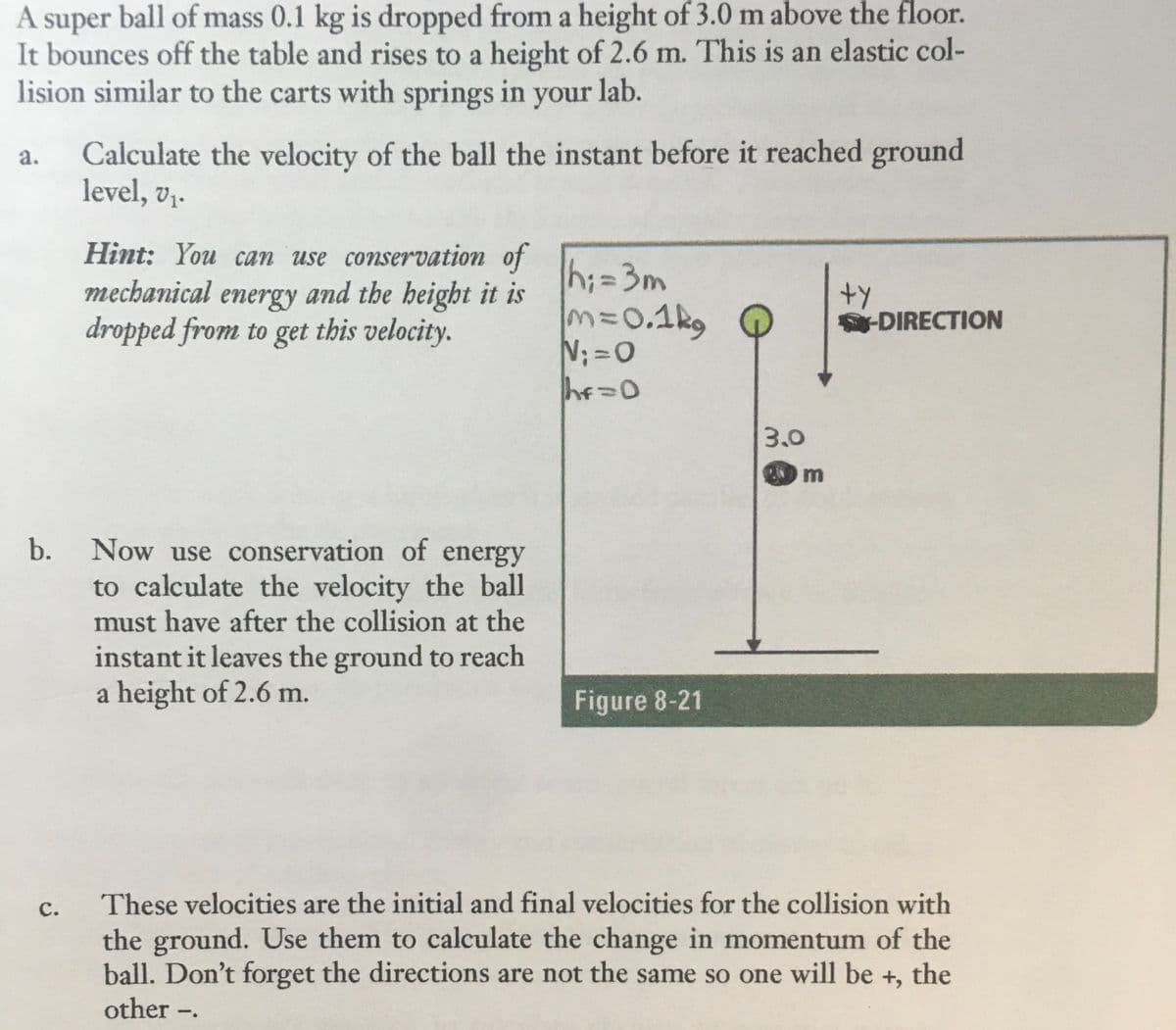A super ball of mass 0.1 kg is dropped from a height of 3.0 m above the floor. It bounces off the table and rises to a height of 2.6 m. This is an elastic col- lision similar to the carts with springs in your lab. Calculate the velocity of the ball the instant before it reached ground level, v1. a. Hint: You can use conservation of mechanical h;=3m m=0.1kg O N; =0 and the height it is +y DIRECTION energy dropped from to get this velocity.
A super ball of mass 0.1 kg is dropped from a height of 3.0 m above the floor. It bounces off the table and rises to a height of 2.6 m. This is an elastic col- lision similar to the carts with springs in your lab. Calculate the velocity of the ball the instant before it reached ground level, v1. a. Hint: You can use conservation of mechanical h;=3m m=0.1kg O N; =0 and the height it is +y DIRECTION energy dropped from to get this velocity.
Principles of Physics: A Calculus-Based Text
5th Edition
ISBN:9781133104261
Author:Raymond A. Serway, John W. Jewett
Publisher:Raymond A. Serway, John W. Jewett
Chapter7: Conservation Of Energy
Section: Chapter Questions
Problem 27P: A child of mass m starts from rest and slides without friction from a height h along a slide next to...
Related questions
Topic Video
Question

Transcribed Image Text:A super ball of mass 0.1 kg is dropped from a height of 3.0 m above the floor.
It bounces off the table and rises to a height of 2.6 m. This is an elastic col-
lision similar to the carts with springs in your lab.
Calculate the velocity of the ball the instant before it reached ground
level, v,.
a.
Hint: You can use conservation of
mechanical energy and the height it is
dropped from to get this velocity.
h;=3m
330.1kg
N;=0
%3D
+y
DIRECTION
3.0
Now use conservation of energy
to calculate the velocity the ball
must have after the collision at the
instant it leaves the ground to reach
a height of 2.6 m.
Figure 8-21
с.
These velocities are the initial and final velocities for the collision with
the ground. Use them to calculate the change in momentum of the
ball. Don't forget the directions are not the same so one will be +, the
other -.
b.
Expert Solution
This question has been solved!
Explore an expertly crafted, step-by-step solution for a thorough understanding of key concepts.
This is a popular solution!
Trending now
This is a popular solution!
Step by step
Solved in 3 steps

Knowledge Booster
Learn more about
Need a deep-dive on the concept behind this application? Look no further. Learn more about this topic, physics and related others by exploring similar questions and additional content below.Recommended textbooks for you

Principles of Physics: A Calculus-Based Text
Physics
ISBN:
9781133104261
Author:
Raymond A. Serway, John W. Jewett
Publisher:
Cengage Learning

Physics for Scientists and Engineers: Foundations…
Physics
ISBN:
9781133939146
Author:
Katz, Debora M.
Publisher:
Cengage Learning

Classical Dynamics of Particles and Systems
Physics
ISBN:
9780534408961
Author:
Stephen T. Thornton, Jerry B. Marion
Publisher:
Cengage Learning

Principles of Physics: A Calculus-Based Text
Physics
ISBN:
9781133104261
Author:
Raymond A. Serway, John W. Jewett
Publisher:
Cengage Learning

Physics for Scientists and Engineers: Foundations…
Physics
ISBN:
9781133939146
Author:
Katz, Debora M.
Publisher:
Cengage Learning

Classical Dynamics of Particles and Systems
Physics
ISBN:
9780534408961
Author:
Stephen T. Thornton, Jerry B. Marion
Publisher:
Cengage Learning

Glencoe Physics: Principles and Problems, Student…
Physics
ISBN:
9780078807213
Author:
Paul W. Zitzewitz
Publisher:
Glencoe/McGraw-Hill